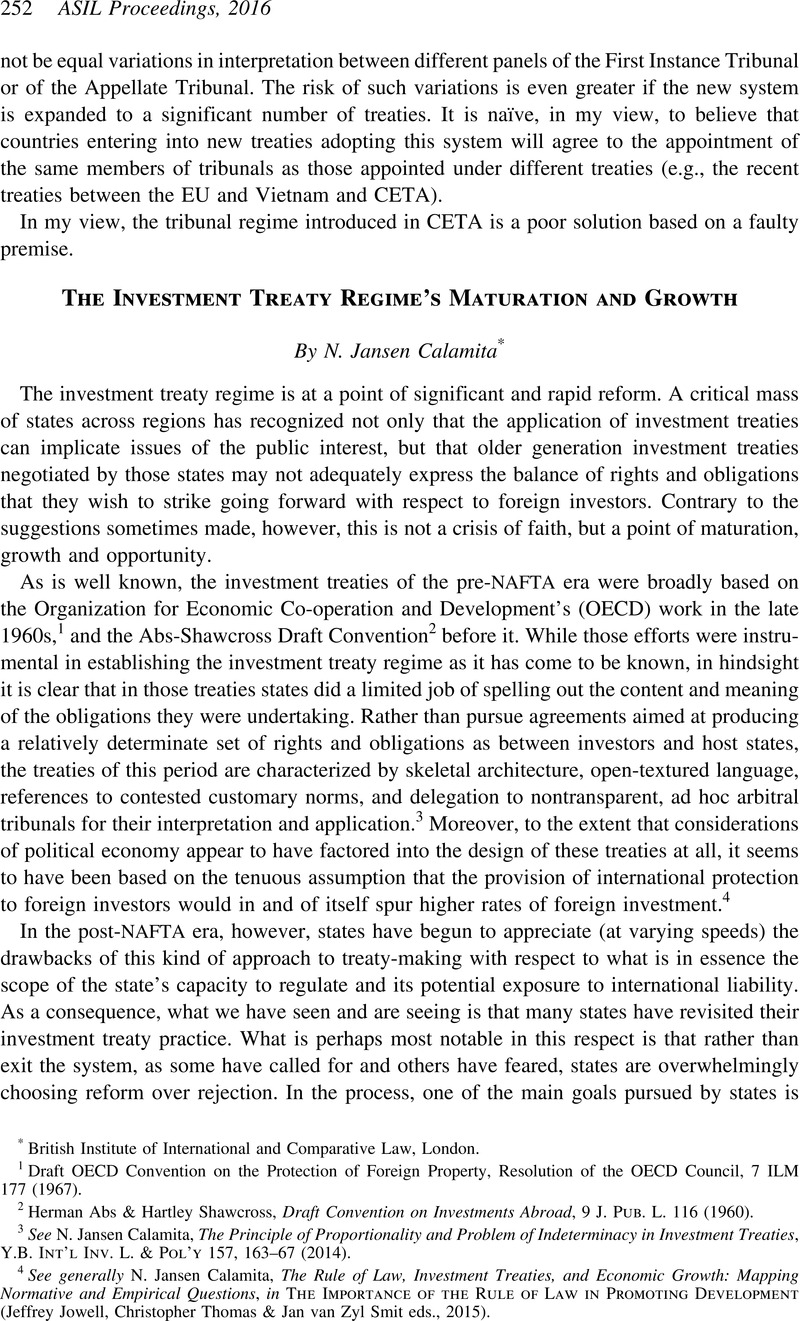No CrossRef data available.
Article contents
The Investment Treaty Regime's Maturation and Growth
Published online by Cambridge University Press: 18 May 2017
Abstract

- Type
- Arbitrating The Public Interest
- Information
- Copyright
- Copyright © American Society of International Law 2016
References
1 Draft OECD Convention on the Protection of Foreign Property, Resolution of the OECD Council, 7 ILM 177 (1967).
2 Abs, Herman & Shawcross, Hartley, Draft Convention on Investments Abroad, 9 J. Pub. L. 116 (1960)Google Scholar.
3 See N. Jansen Calamita, The Principle of Proportionality and Problem of Indeterminacy in Investment Treaties, Y.B. Int'l Inv. L. & Pol’y 157, 163–67 (2014).
4 See generally N. Jansen Calamita, The Rule of Law, Investment Treaties, and Economic Growth: Mapping Normative and Empirical Questions, in The Importance of the Rule of Law in Promoting Development (Jeffrey Jowell, Christopher Thomas & Jan van Zyl Smit eds., 2015).
5 See generally United Nations Conference on Trade and Development, Investment Policy Framework for Sustainable Development (2015).
6 EU-Canada Comprehensive Economic and Trade Agreement (Feb. 29, 2016 version), Art. 8.10; EU-Vietnam Free Trade Agreement (Jan. 2016 version), Art. 14; EU-Singapore Free Trade Agreement (May 2015 version), ch. 9, Art. 9.4.
7 Trans-Pacific Partnership (signed Feb. 4, 2016), Drafters’ Note on Interpretation of “In Like Circumstances” Under Article 9.4 (National Treatment) and Article 9.5 (Most-Favored-Nation Treatment), at https://www.tpp.mfat.govt.nz/assets/docs/Interpretation%20of%20In%20Like%20Circumstances.pdf.
8 Trans-Pacific Partnership (signed Feb. 4, 2016), Art. 29.5.
9 See, e.g., United States Model Bilateral Investment Treaty (2004), Art. 20.1; Canada-Peru Free Trade Agreement (2009), Art. 1110; Canada-Chile Free Trade Agreement (1997), Annex G-09.1; ASEAN Comprehensive Investment Agreement (2009), Art. 16; China-Japan-Korea Trilateral Investment Treaty (2012), Arts. 19–20.
10 See, e.g., Trans-Pacific Partnership, supra note 8 ASEAN Comprehensive Investment Agreement (2009).
11 See, e.g., Al Tamimi v. Sultanate of Oman, ICSID Case No ARB/11/33, Award, paras. 382–99 (Nov. 3, 2015) (interpreting the international minimum standard of treatment in the United States-Oman Free Trade Agreement).
12 See N. Jansen Calamita & Ewa Zelazna, The Changing Landscape of Transparency in Investor-State Arbitration: The UNCITRAL Transparency Rules and Mauritius Convention, Austrian Y.B. Int'l Arb. 271–88 (2016).
13 See, e.g., EU-Vietnam Free Trade Agreement, supra note 6, Arts. 12–14.
14 As of May 1, 2016, sixteen states had signed the Convention and only one had ratified it: Belgium, Canada, Congo, Finland, France, Gabon, Germany, Italy, Luxembourg, Madagascar, Mauritius (ratified), Sweden, Switzerland, Syrian Arab Republic, United Kingdom, and the United States.
15 EU-Canada CETA, supra note 6, Art. 8.39; EU-Vietnam Free Trade Agreement, supra note 15, Art. 27; EUSingapore Free Trade Agreement, supra note 6, ch. 9, Art. 9.24.
16 India Model Bilateral Investment Treaty, Art. 5.6 (2015).
17 Schwebel, Stephen M., The Influence of Bilateral Treaties on Customary Law, 28 ASIL Proc. 27, 30 (2004)Google Scholar.




